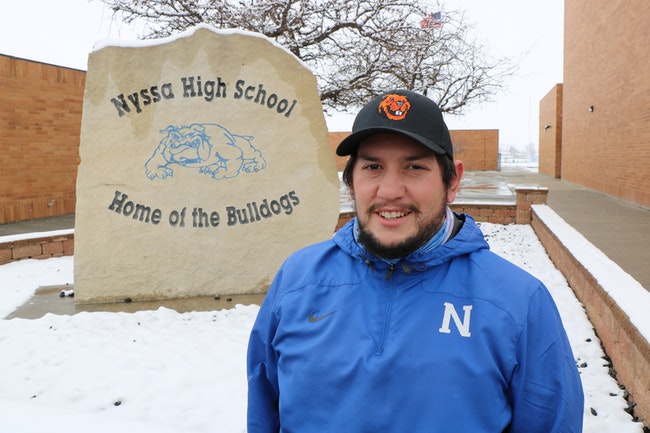
Bobby DeLeon, counselor at Nyssa High School, says the mental health system runs up agains cultural values and other factors in the communities he serves. (Liliana Frankel/The Enterprise)
VALE – A recent state report about mental health in the Latino community showed that while Latino youth are seeking mental healthcare at high rates, there is still a lack of services in rural areas like Malheur County, where 33% of the population is Latino.
Malheur County has the second-highest ratio of Latino to other residents by county in Oregon. Of counties with a high population of Latinos, it has the third-highest ratio of residents to mental healthcare providers – 1,223 to 1. Experts say that this isn’t enough.
“Access to any mental health providers, especially culturally specific mental health providers, is particularly scarce” in rural counties, the report said.
“Access in and of itself is a challenge,” said Gustavo Morales, the executive director of EUVALCREE, a nonprofit based in Ontario that works with the Latino community. “We have limited behavioral and mental health providers, and even with those providers, waitlists go between three to six months. Those disparities are even more exacerbated with communities that have challenges with linguistic and cultural access. A lot of what’s needed for these community members requires consistent support. It’s a challenge of supply and demand.”
On the bright side, Latino youth are more likely to access mental healthcare via school networks and referrals, the report said.
“Schools are particularly robust access points for Latino/a/x rural youth and their families,” the report said. “Qualitative research…found that culturally specific and rural mental health providers who serve the Latino/a/x community believe schools are an effective and promising platform for mental health services for the Latino/a/x community.”
Local educators say that they are working to to intervene with youth through school-based mental health resources.
“There’s been a particular focus on making sure that we’re addressing the mental health needs of all historically underserved students,” said Jennifer Susuki, student wellness coordinator with the Malheur Education Service District. “There’s a training on emotional poverty, there’s quite a few trauma-informed care professional development (opportunities). So that’s the primary thing we’re doing, is making sure that everybody’s educated and knows some of the signs to look for to make sure that kids are doing well.”
Susuki outlined other initiatives aimed at increasing equity in behavioral health services at local schools. These include a student-led program meant to address mental illness and suicidal ideation, state-funded “equity-based training and technical assistance” regarding student safety and suicide prevention, and hiring an inclusion specialist to review preschool suspensions through an equity lens.
Bobby DeLeon serves as the counselor for Nyssa High School, whose student body is nearly 70% Latino.
DeLeon, who is also Latino, said that he identified with the section of the report which charged that the mental health system’s focus on individuality in care are “in direct conflict with Latino/a/x cultural values of interdependence and community.”
“When I grew up you just didn’t go to individualized counseling,” he said. “It’s more of a community base. I think we change our approach to those counseling scenarios to understand that culture.”
“There’s still a stigma around mental health, and that’s not specific to Latinx (people),” said Susuki. “As far as families go, it’s hard for our rural families to get in to access mental health in Ontario, and so we’ve been working with some partnerships with agencies here in town that maybe we can expand those hours or have satellite sites that families can access.”
In addition to the transportation and scheduling obstacles that Susuki highlighted, the report said that Latino youth are more likely to see their care disrupted. The report cited issues such as termination of their care before treatment is finished, actual or perceived violation of clinic rules and regulations, and a parent or guardian withdrawing from the clinical setting.
The report said such interruptions likely indicated a poor fit between clinical providers and their Latino patients.
“We have a high number of Spanish speakers in our community and a low number of Spanish-speaking providers,” DeLeon pointed out. “That would make sense why there could be that sort of number, because maybe the parents aren’t feeling comfortable because they’re not able to communicate with that individual’s counselor.”
Factors such as language contribute to what Malheur County Health Department Director Sarah Poe identified as “social determinants of health.” The term refers to social factors, like English proficiency, income level, and access to prevention education, that can affect health from mental health to teen pregnancy.
“We recognize that if you are somebody that identifies as Latinx in our community, there are often these social determinants of health that impact you in a more negative way,” Poe said. “If you are a Hispanic single mom in Malheur County, your average income is $15,000 a year. So that also ties into our 30% childhood poverty rate.”
“The report that came out focused specifically on Latinos,” said Morales, “but I believe that it would have very similar outcomes among other communities because it’s a systems issue, not a race issue.”
To improve mental health services in Malheur County, he said, circumstances should change to “allow more providers to expand their services to include behavioral and mental health.”
“A lot of (the problems) have to do with how the system is set up,” said Morales. “It’s hard to gain access for everybody.”
News tip? Contact Liliana Frankel at [email protected] or 267-981-5577.
YOU CAN SUPPORT THIS KIND OF WORK
The Enterprise relies on community support to fund vital local journalism. You can help us do more.
SUBSCRIBE: A monthly digital subscription is $5 a month.
GIFT: Give someone you know a subscription.
ONE-TIME PAYMENT: Contribute, knowing your support goes towards more local journalism you can trust.




